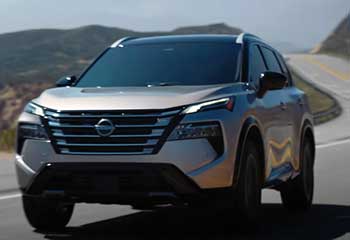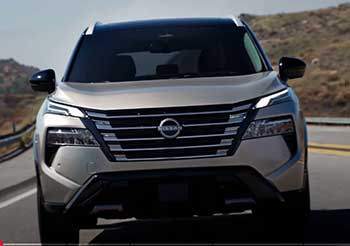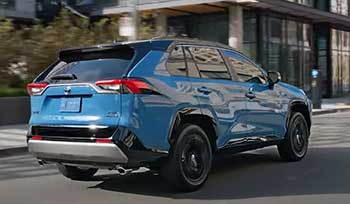
I’ve spent time behind the wheel of both the 2025 Nissan Rogue and Toyota RAV4, two compact SUVs that dominate the market with their blend of practicality, style, and tech.
My goal here is to break down their strengths and weaknesses, sharing my firsthand insights to help you decide which one fits your life best.
From performance to comfort, safety to cargo space, I’ll compare these vehicles in detail, highlighting what makes each shine and where they fall short.
Whether you’re a daily commuter or an adventure seeker, this comparison will guide you toward the right choice.
Comparison Table
| Feature | Nissan Rogue (2025) | Toyota RAV4 (2025) |
|---|---|---|
| Starting MSRP | $29,230 | $29,250 |
| Engine | 1.5L 3-cylinder, 201 hp, 225 lb-ft torque | 2.5L 4-cylinder, 203 hp, 184 lb-ft torque |
| Transmission | CVT | 8-speed automatic |
| Fuel Economy (FWD) | 30/37/33 MPG (city/highway/combined) | 27/35/30 MPG (city/highway/combined) |
| Hybrid Option | No | Yes, 41/38/39 MPG (Hybrid LE) |
| Towing Capacity | 1,500 lbs | 1,500 lbs (up to 3,500 lbs for Adventure/TRD) |
| Cargo Space (rear seats up) | 31.6 cu. ft. | 37.6 cu. ft. |
| Max Cargo Space | 74.1 cu. ft. | 69.8 cu. ft. |
| Infotainment | 8-in or 12.3-in touchscreen, NissanConnect | 8-in or 10.5-in touchscreen, Toyota Audio Multimedia |
| Safety Features | Nissan Safety Shield 360 (standard) | Toyota Safety Sense 2.5 (standard) |
| AWD Availability | All trims | Select trims |
| Ground Clearance | 8.2 in | 8.4–8.6 in |
My Experience With The Nissan Rogue
I recently drove the 2025 Nissan Rogue SL AWD through a mix of city streets and winding backroads, and it left a strong impression with its polished ride and upscale cabin. The Rogue’s 1.5-liter turbocharged three-cylinder engine, delivering 201 horsepower and 225 lb-ft of torque, felt surprisingly peppy for its size.
It’s paired with a continuously variable transmission (CVT) that, while smooth, occasionally lagged during quick acceleration, making me wish for a bit more immediacy. The interior, especially in the SL trim, felt like a step above the norm, with soft-touch materials and a sleek 12.3-inch touchscreen that was intuitive to use. The Divide-N-Hide cargo system was a clever touch, letting me organize gear effortlessly.
On the road, the Rogue handled with confidence, soaking up bumps and offering a quiet cabin that made long drives relaxing. Its five drive modes—Auto, Eco, Sport, Snow, and Off-Road—gave me flexibility, though I found the Snow mode particularly helpful during a light drizzle.
The Nissan Safety Shield 360 suite, standard across all trims, gave me peace of mind with features like blind-spot monitoring and rear cross-traffic alert. However, the cargo space (31.6 cubic feet with seats up) felt a bit tight compared to competitors, and the lack of a hybrid option was a noticeable gap for fuel-conscious drivers like me.
The Rogue’s design is sleek, with a modern V-shaped grille and boomerang headlights that turn heads. I appreciated the versatility of all-wheel drive (AWD) being available across all trims, unlike some rivals.
Still, the towing capacity maxes out at 1,500 pounds, which might limit those needing to haul heavier loads. Overall, the Rogue felt like a refined, tech-savvy choice for someone prioritizing comfort and style over raw power or off-road prowess.
Pros Of The Nissan Rogue
- Responsive Engine: The 1.5-liter turbo three-cylinder offers 201 horsepower and 225 lb-ft of torque, providing solid acceleration for daily driving.
- Upscale Interior: Soft-touch materials and quilted leather in higher trims like the Platinum create a premium feel that rivals pricier SUVs.
- Standard Safety Features: Nissan Safety Shield 360 includes automatic emergency braking, blind-spot monitoring, and rear cross-traffic alert as standard.
- Versatile Drive Modes: Five modes (Auto, Eco, Sport, Snow, Off-Road) adapt to various conditions, enhancing control in diverse environments.
- Spacious Front Row: With 41.5 inches of legroom, the Rogue offers ample space for taller drivers, making long trips comfortable.
- NissanConnect System: The 12.3-inch touchscreen is user-friendly, with Apple CarPlay, Android Auto, and optional Bose audio for tech lovers.
- AWD Across All Trims: Every Rogue trim offers optional AWD, providing flexibility for those in snowy or rugged regions.
The Rogue’s cabin stood out during my test drive, especially the plush seats and intuitive controls. The Divide-N-Hide system was a game-changer for organizing camping gear, and the standard safety features made navigating busy streets stress-free.
Fuel economy (30/37 MPG city/highway for FWD) is a strong point, beating many competitors. However, I noticed the CVT could feel sluggish when merging onto highways, which might bother performance enthusiasts.
Cons Of The Nissan Rogue

- Limited Cargo Space: With only 31.6 cubic feet behind the rear seats, the Rogue trails competitors like the RAV4 in storage capacity.
- No Hybrid Option: Unlike many rivals, the Rogue lacks a hybrid or plug-in hybrid, limiting options for eco-conscious buyers.
- CVT Lag: The continuously variable transmission can feel hesitant during quick acceleration, reducing responsiveness.
- Low Towing Capacity: Capped at 1,500 pounds, the Rogue isn’t ideal for towing heavier loads like boats or trailers.
- Mixed Safety Ratings: While NHTSA gives it five stars, IIHS rates it “Marginal” in moderate overlap front tests, raising some concerns.
- Smaller Rear Legroom: Rear passengers get 38.5 inches of legroom, less than some competitors, which could feel cramped for adults.
- Basic Base Trim: The S trim’s 8-inch touchscreen and four-speaker audio feel underwhelming compared to higher trims or rivals.
The cargo space was a letdown when I tried fitting larger items, and the absence of a hybrid option made me question its long-term value with rising gas prices. The CVT’s occasional sluggishness was noticeable during merges, and the IIHS safety scores gave me pause, especially for a family-oriented SUV. While the Rogue shines in comfort, these drawbacks could sway buyers toward other options.
Maintenance Tips For The Nissan Rogue
- Regular Transmission Fluid Changes: The CVT requires fluid changes every 40,000 miles to prevent wear; I learned this from owners who faced early issues.
- Monitor Tire Pressure: Check monthly to maintain the all-season tires’ performance, especially for AWD models tackling rough terrain.
- Oil Changes Every 5,000–7,500 Miles: Stick to synthetic oil to keep the 1.5-liter engine running smoothly, as I found it sensitive to neglect.
- Inspect Brakes Annually: The Rogue’s braking system handles well but needs yearly checks to ensure responsiveness, especially in stop-and-go traffic.
- Update NissanConnect Software: Keep the infotainment system updated via Nissan’s app to avoid glitches, which I noticed on older models.
- Clean Cabin Air Filter: Replace every 15,000 miles to maintain air quality, as I found the cabin could get stuffy without this.
- Check Battery Health: The Rogue’s battery can drain faster in cold climates, so test it yearly to avoid unexpected failures.
Maintaining the Rogue is straightforward, but the CVT demands attention, as I’ve heard horror stories about costly repairs when neglected. During my drive, the tires felt responsive, but proper pressure is key for efficiency. Regular oil changes kept the engine purring, and updating the infotainment prevented lag. These steps ensure the Rogue stays reliable for years.
Also read: My Thoughts on Ford Edge Vs. Hyundai Tucson
My Experience With The Toyota RAV4
Driving the 2025 Toyota RAV4 XLE AWD was a different vibe—rugged, versatile, and packed with options. Its 2.5-liter four-cylinder engine, producing 203 horsepower, felt punchier than the Rogue’s, especially when I pushed it on highways. The eight-speed automatic transmission shifted smoothly, offering a more engaging drive than the Rogue’s CVT. The RAV4’s interior was functional but less luxurious, with some hard plastics that reminded me it’s not a premium brand. The 8-inch touchscreen (10.5-inch on higher trims) was intuitive, with wireless Apple CarPlay and Android Auto as standard.
The RAV4’s hybrid option, which I tested briefly, was a standout, delivering 41/38 MPG (city/highway) and 219 horsepower. Its towing capacity impressed me, reaching 3,500 pounds in Adventure and TRD Off-Road trims, perfect for small trailers. The Multi-Terrain Select dial (Mud, Sand, Rock, Snow) made light off-roading a breeze, though it’s no hardcore trailblazer. Cargo space (37.6 cubic feet with seats up) easily swallowed my gear, and Toyota Safety Sense 2.5 added confidence with features like lane-tracing assist. However, the rear legroom (37.8 inches) felt snug, and the ride was noisier than the Rogue’s.
The RAV4’s rugged styling, with sharp angles and aggressive wheel arches, screamed adventure. Its availability in hybrid and plug-in hybrid (RAV4 Prime) models gave it an edge for eco-minded drivers. Still, some safety ratings (IIHS “Marginal” in moderate overlap tests) and a dated interior design were minor drawbacks. For those prioritizing versatility and efficiency, the RAV4 is tough to beat.
Pros Of The Toyota RAV4
- Hybrid and Plug-In Options: The RAV4’s hybrid (41/38 MPG) and Prime models offer superior fuel economy and 219 horsepower.
- Higher Towing Capacity: Adventure and TRD trims tow up to 3,500 pounds, ideal for small boats or trailers.
- Generous Cargo Space: 37.6 cubic feet behind the rear seats beats the Rogue, making it great for families or road trips.
- Off-Road Capability: Multi-Terrain Select and 8.6 inches of ground clearance handle light trails better than the Rogue.
- Smooth Transmission: The eight-speed automatic shifts crisply, offering a more dynamic drive than the Rogue’s CVT.
- Toyota Safety Sense 2.5: Standard features like pre-collision warning and adaptive cruise control enhance safety.
- Wide Trim Range: From LE to Limited, plus Adventure and TRD, there’s a RAV4 for every lifestyle.
The hybrid’s efficiency was a game-changer during my test, saving me trips to the pump. The cargo space easily fit my camping gear, and the off-road modes handled gravel paths with ease. Toyota’s reputation for reliability also gave me confidence, backed by a 4.0/5.0 RepairPal rating. The RAV4 feels like a do-it-all SUV for practical buyers.
Cons Of The Toyota RAV4

- Dated Interior Design: Hard plastics and a utilitarian layout make the cabin feel less upscale than the Rogue’s.
- Noisy Ride: Wind and road noise were more noticeable than in the Rogue, especially at highway speeds.
- Tight Rear Legroom: With 37.8 inches, the back seat feels cramped for taller passengers on long drives.
- Mixed Safety Ratings: IIHS gives a “Marginal” score in moderate overlap front tests, which could concern safety-focused buyers.
- AWD Not Universal: Unlike the Rogue, AWD is only available on select trims, limiting options for some buyers.
- Base Trim Lacks Features: The LE’s six-speaker audio and lack of adaptive cruise control feel basic for the price.
- Higher Starting Price: At $29,250, the RAV4 is slightly pricier than the Rogue’s $29,230 base MSRP.
The interior’s hard plastics were a letdown compared to the Rogue’s plush cabin, and the noisy ride bothered me on longer trips. Rear legroom was tight for my taller friends, and the IIHS ratings raised an eyebrow. While the RAV4 excels in versatility, these flaws might push luxury-seekers elsewhere.
Maintenance Tips For The Toyota RAV4
- Oil Changes Every 7,500–10,000 Miles: Use synthetic oil for the 2.5-liter engine or hybrid to maintain efficiency, as I noticed smoother performance.
- Check Hybrid Battery Health: For hybrid models, inspect the battery every 30,000 miles to ensure longevity, per dealer advice.
- Rotate Tires Every 5,000 Miles: This keeps the all-season or all-terrain tires wearing evenly, especially for AWD trims.
- Inspect Brake Pads: Check every 20,000 miles, as I found the RAV4’s brakes wear faster with frequent city driving.
- Clean Air Filters: Replace engine and cabin filters every 15,000 miles to optimize performance and air quality.
- Update Multimedia Software: Keep the Toyota Audio Multimedia system updated to avoid connectivity issues with Apple CarPlay.
- Monitor Coolant Levels: Check every 10,000 miles, especially for hybrids, to prevent overheating during long trips.
The RAV4’s maintenance is low-cost, with RepairPal estimating $429 annually. I found tire rotations critical for off-road trims, and the hybrid battery check was a must for peace of mind. Regular software updates kept the infotainment glitch-free, ensuring a reliable ride.
Also read: My Thoughts on Acura ILX Vs. Honda Accord
Frequently Asked Questions (FAQ)
It depends on your priorities. The Rogue offers a luxurious interior and better fuel economy, while the RAV4 excels with hybrid options and towing capacity.
The RAV4 is better for eco-conscious buyers or those needing to tow, while the Rogue suits those prioritizing comfort and tech at a lower price.
Yes, the Rogue scores a 4.0/5.0 on RepairPal, with $467 average annual repair costs, though CVT issues require regular maintenance.
The RAV4 has a dated interior, noisy ride, tight rear legroom, mixed IIHS safety ratings, and AWD limited to select trims.
Conclusion: For Nissan Rogue And Toyota RAV4
Choosing between the Nissan Rogue and Toyota RAV4 comes down to what you value most. If you want a refined cabin, versatile AWD, and better fuel economy, the Rogue is your pick. Its upscale interior and tech make daily drives a pleasure, though it lacks a hybrid and has limited cargo space.
If you prioritize efficiency, towing, or off-road capability, the RAV4’s hybrid options and rugged versatility shine, despite a noisier ride and dated interior. Test-drive both to see which fits your lifestyle—I lean toward the RAV4 for its hybrid, but the Rogue’s comfort is hard to beat.

